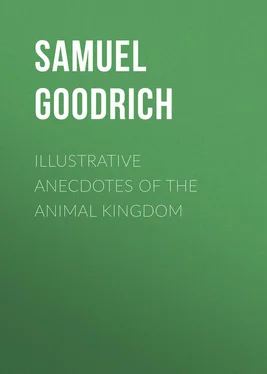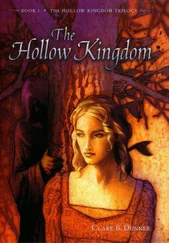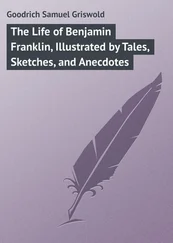Samuel Goodrich - Illustrative Anecdotes of the Animal Kingdom
Здесь есть возможность читать онлайн «Samuel Goodrich - Illustrative Anecdotes of the Animal Kingdom» — ознакомительный отрывок электронной книги совершенно бесплатно, а после прочтения отрывка купить полную версию. В некоторых случаях можно слушать аудио, скачать через торрент в формате fb2 и присутствует краткое содержание. Жанр: Природа и животные, foreign_prose, на английском языке. Описание произведения, (предисловие) а так же отзывы посетителей доступны на портале библиотеки ЛибКат.
- Название:Illustrative Anecdotes of the Animal Kingdom
- Автор:
- Жанр:
- Год:неизвестен
- ISBN:нет данных
- Рейтинг книги:3 / 5. Голосов: 1
-
Избранное:Добавить в избранное
- Отзывы:
-
Ваша оценка:
- 60
- 1
- 2
- 3
- 4
- 5
Illustrative Anecdotes of the Animal Kingdom: краткое содержание, описание и аннотация
Предлагаем к чтению аннотацию, описание, краткое содержание или предисловие (зависит от того, что написал сам автор книги «Illustrative Anecdotes of the Animal Kingdom»). Если вы не нашли необходимую информацию о книге — напишите в комментариях, мы постараемся отыскать её.
Illustrative Anecdotes of the Animal Kingdom — читать онлайн ознакомительный отрывок
Ниже представлен текст книги, разбитый по страницам. Система сохранения места последней прочитанной страницы, позволяет с удобством читать онлайн бесплатно книгу «Illustrative Anecdotes of the Animal Kingdom», без необходимости каждый раз заново искать на чём Вы остановились. Поставьте закладку, и сможете в любой момент перейти на страницу, на которой закончили чтение.
Интервал:
Закладка:
Like the brown and black bear, polar bears are animals capable of great fierceness. Brentz, in his voyage in search of the north-east passage to China, had horrid proofs of their ferocity in the Island of Nova Zembla, where they attacked his seamen, seizing them in their mouth, carrying them off with the utmost ease, and devouring them even in sight of their comrades.
About twenty years ago, the crew of a boat belonging to a ship in the whale fishery, shot at a bear some little distance off, and wounded him. The animal immediately set up a dreadful howl, and scampered along the ice towards the boat. Before he reached it, he had received a second wound. This increased his fury, and he presently plunged into the water, and swam to the boat; and, in his attempt to board it, he placed one of his fore paws upon the gunwale, and would have gained his point, had not one of the sailors seized a hatchet and cut it off. Even this had not the effect of damping his courage; for he followed the boat till it reached the ship, from whence several shots were fired at him, which hit, but did not mortally wound him: he approached the vessel, and ascended the deck, where, from his dreadful fury, he spread such consternation, that all the crew fled to the shrouds, and he was in the act of pursuing them thither, when an effective shot laid him dead on the deck.
THE RACCOON
This animal is peculiar to America. He resembles the bear, but is much smaller and more elegantly formed. He is an active and lively animal; an excellent climber of trees, in which the sharpness of his claws greatly aids him; and he will even venture to the extremity of slender branches. He is a good-tempered animal, and, consequently, easily tamed; but his habit of prying into every thing renders him rather troublesome, for he is in constant motion, and examining every object within his reach. He generally sits on his hinder parts when feeding, conveying all his food to his mouth with his fore paws. He will eat almost every kind of food, but is particularly fond of sweetmeats, and will indulge in spirituous liquors even to drunkenness. He feeds chiefly at night, in a wild state, and sleeps during the day.
Brickell gives an interesting account, in his "History of North Carolina," of the cunning manifested by the raccoon in pursuit of its prey. "It is fond of crabs, and, when in quest of them, will take its station by a swamp, and hang its tail over into the water, which the crabs mistake for food, and lay hold of it; as soon as the raccoon feels them pinch, it pulls up its tail with a sudden jerk, and they generally quit their hold upon being removed from the water. The raccoon instantly seizes the crabs in its mouth, removes them to a distance from the water, and greedily devours its prey. It is very careful how it takes them up, which it always does from behind, holding them transversely, in order to prevent their catching its mouth with their nippers."
When enraged, or desirous of attacking a person, the raccoon advances with arched back and bristling hair, and with its chin or under jaw close to the ground, uttering gruff sounds of displeasure. If once injured, it seldom forgives its enemy. On one occasion, a servant struck a tame raccoon with a whip: in vain did he afterwards attempt a reconciliation; neither eggs, nor food most coveted by the animal, availed in pacifying it. At his approach, it flew into a sort of fury; it darted at him with sparkling eyes, uttering loud cries.
Its accents of anger were very singular; sometimes one might fancy them the whistling of the curlew, at others, the hoarse bark of an old dog. If any one beat it, it opposed no resistance; it concealed its head and its paws, like the hedgehog, by rolling itself into a ball. In this position it would suffer death. When its chain broke, it would allow no one to approach it, and it was with great difficulty refettered.
THE COATI
This animal, which frequents the woods of South America, resembles the raccoon, but is smaller. He is in the habit of rooting under trees, and thus overturns many of them, even those of large size. The most curious incident in his history, is that he eats his own tail! This is explained by Godman as follows: "The extreme length of its tail, in which the blood circulates but feebly, exposes it to the influence of cold or frost; and the exceedingly tormenting irritation produced thereby leads the animal to gnaw and scratch the tail, to relieve the excessive itching. The disease spreads, and the anguish induces the coati to gnaw more furiously, and eventually its life is destroyed by the extension of the inflammation and irritability to the spine."
THE BADGER
Of this animal there are two species, one European, the other American; but they have a strong resemblance. It has short legs, and a long body; lives in burrows by day, and goes forth at night to prey on roots, snails, and worms. The American species seems to be more carnivorous than his foreign relation: in this respect he has high example, for the people of America eat more butcher's meat than those of Europe – for the reason, however, that they are so fortunate as to be able to get it.
In Europe, the badger is hunted as a matter of sport, the chief amusement being derived from the fierce resistance he makes to the dogs. In South America, the creature is eaten, and badger hams are deemed a delicacy. Catching this animal is a great source of interest to the Indians. We are told that a "party of eight, in one of their expeditions, will destroy two or three hundred badgers, and a quantity of deer on their return home, besides guanas. These hunting parties are so delightful, even to the women, that the hopes of being allowed to accompany the men will make them behave well all the year. On these excursions they live well, and seem more happy than during the rainy season; in their way home, they travel day and night rapidly, in spite of obstructions, carrying long poles between them, on which the animals are slung – the boys carrying the skins and lard; the dogs too are well fed during this period, and seem to return with regret. A cloud of vultures generally hover over them, and are seen by their clans a day or two before they arrive, who make every preparation to receive them; their return is greeted like that of victors. The rainy nights are passed in recounting their exploits one to another."
The habits of the badger are said to be "the most social of any quadruped in the universe; it is not known to quarrel with any other animal; even the fox, polecat, opossum, land crab, and snake, make it resign its abode, although it is much stronger than any of them. It also lives in the greatest harmony with its own species, subsisting principally on nuts, roots, and vegetables; it is cleanly in its habits, being observed to perform its ablutions while the dew is on the ground."
THE GLUTTON
This animal, which is called wolverene in this country, and carcajou by the Canadians, is about three feet long, and of a dark-brown color. It is strong and courageous, and will even attack and destroy the fox in its burrow. Its extraordinary voracity gives the impulse to all its exertions. Incessantly in search of food, it kills animals larger and stronger than itself, seizes the deer which the hunter has just shot, plunders the baits on his traps, or the game these have taken. A proof at once of the strength, the cunning, and the strong appetite, of the glutton, was afforded by one, at Hudson's Bay, some years since, which overset the greatest part of a pile of wood of great extent, which contained a whole winter's firing; his object was to get at some provisions that had been hidden there by the company's servants when going to the factory to spend the Christmas holidays.
Читать дальшеИнтервал:
Закладка:
Похожие книги на «Illustrative Anecdotes of the Animal Kingdom»
Представляем Вашему вниманию похожие книги на «Illustrative Anecdotes of the Animal Kingdom» списком для выбора. Мы отобрали схожую по названию и смыслу литературу в надежде предоставить читателям больше вариантов отыскать новые, интересные, ещё непрочитанные произведения.
Обсуждение, отзывы о книге «Illustrative Anecdotes of the Animal Kingdom» и просто собственные мнения читателей. Оставьте ваши комментарии, напишите, что Вы думаете о произведении, его смысле или главных героях. Укажите что конкретно понравилось, а что нет, и почему Вы так считаете.












